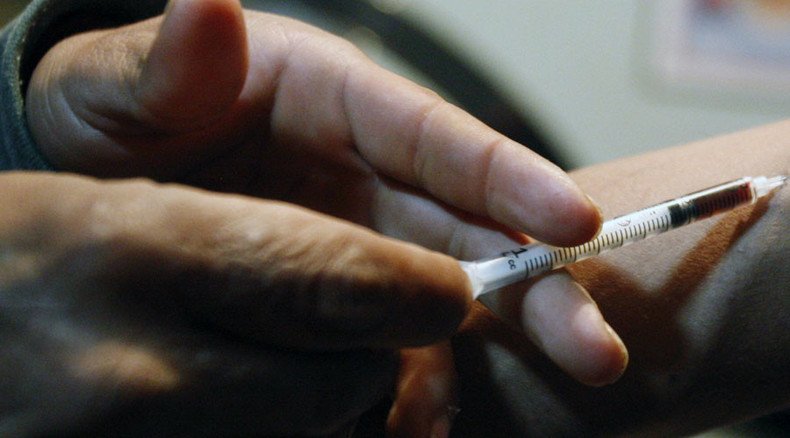120 deaths a day: US heroin & prescription drugs epidemic spinning out of control

American lawmakers are grappling with ways to respond to a worsening heroin epidemic. Drug overdoses are now the leading cause of death in the US, surpassing car accidents and gunshot wounds, according to the Centers for Disease Control and Prevention.
Lawmakers attending a House of Representatives judicial committee hearing on Tuesday learned that the number of people overdosing on opioids has quadrupled in the past decade, with many deaths occurring in the upper class, particularly among women and in suburban areas.
“There were over 43,000 deaths in 2013, or approximately 120 per day, over half of which involved either a prescription painkiller or heroin. These are our family members, friends, neighbors, and colleagues,” Jack Riley, acting deputy administrator of the Drug Enforcement Agency, told the committee.
Drug deaths now outnumber deaths from gunshot wounds (over 33,600) and motor vehicle crashes (over 32,700) in the United States, according to the CDC.
Riley said there are more than 600,000 heroin users in the US today, and agency officials say the figure is likely to be undercounted, as it is based on a household survey and wouldn’t account for all heroin users among homeless populations.
The sheer volume of heroin that is coming into the country and the number of people turning to it has been driving the levels of drug abuse up, according to analysts. Between 2008 and 2012, the DEA saw a 232 percent increase in drug busts along the Mexican border. Last year alone, agents seized 281 kilograms of heroin.
The biggest gateway to heroin is an addiction to prescription drugs. Increases in overdoses seen among women and the wealthy may be accounted for by previous addiction to prescribed pills, according to the CDC. When pills become too expensive or difficult to obtain, people may have turn to a cheaper alternative – heroin at $10 a bag.
What is also unique about the opioid epidemic is that it is no longer just a border or urban problem, but a suburban problem as well. Local law enforcement has largely been left to handle the epidemic on their own, but they are increasingly looking for answers from the federal level. The DEA and other experts see a connection between drug cartels and small street gangs in local towns like Chesapeake, Virginia.
READ MORE: Deadly US heroin epidemic driven by whites, women and the rich – CDC survey
Testifying at Tuesday’s hearing, Nancy Parr, commonwealth attorney for Chesapeake, commented on this.
“We’ve seen an increase in prostitution in Chesapeake because that is the way some women are making their money to support their habits,” said Parr.
“As far as distributing the heroin, that would be [evident by] the gun battles that are happening on our city streets and in neighborhoods that expose innocent people to the gunfire.”
Senator Ed Markey (D-Massachusetts) has introduced a bill that would require prescribers to complete training on best practices for pain management before getting a license to prescribe controlled substances.
.@HouseJudiciary hearing on "America’s Growing #Heroin Epidemic" – LIVE online here: http://t.co/PsEraKXVjBpic.twitter.com/5Sq1eCFaWY
— CSPAN (@cspan) July 28, 2015The Obama administration, recognizing the public health implications of heroin addiction and overdose deaths, has brought increased attention to the problem and been pursuing a federal response to the epidemic by supporting education about drug use and addressing addiction problems.
“To address the overdose death issue, we have been working to increase access to naloxone [antidote for heroin overdoses] for first responders and individuals close to those with opioid drug disorders,” said Michael Botticelli, director of the White House Office of National Drug Control Policy told the committee.
The FDA recently approved a newer auto-injector version of naloxone designed for use by family members and caregivers.
Botticelli also said the administration is expanding training among federal health providers, and at the Bureau of Prisons and the Department of Defense.












